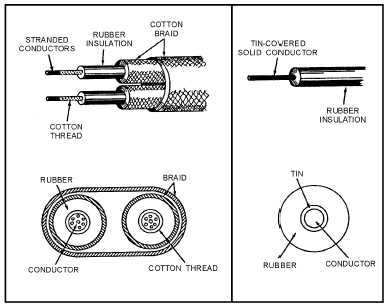1-15
Figure 1-7.—Rubber insulation.
Referring to the enlarged cross-sectional view in figure 1-7, note that a thin coating of tin separates
the copper conductor from the rubber insulation. If the thin coating of tin were not used, a chemical action
would take place and the rubber would become soft and gummy where it makes contact with the copper.
When small, solid, or stranded conductors are used, a winding of cotton threads is applied between the
conductors and the rubber insulation.
CODE-GRADED RUBBER.—Code-graded rubber is the standard that the National Electrical
Code (NEC) has adopted as the minimum requirements for rubber insulation as specified by
Underwriters' Laboratories. In this code system, the letter R indicates the use of a rubber insulator. Type
R signifies that the wire is rubber coated.
The NEC codes Type RH and Type RHH signify a rubber heat-resistant compound. Type RW
signifies a rubber moisture-resistant compound. A Type RHW signifies a rubber heat- and moisture-
resistant compound. Type RHW is approved for use in wet or dry locations at a maximum conductor
temperature of 75º C. Neoprene, a low-voltage compound, is the one exception to Type RHW. Although
not a rubber compound, neoprene meets the requirements of Underwriters' Laboratories and was
designated Type RHW.
LATEX RUBBER.—Latex rubber is a high-grade compound consisting of 90 percent unmilled
grainless rubber. There are two designations for this type of insulation: Type RUH and Type RUW. Type
RUH (rubber unmilled heat-resistant) is used in dry locations when the conductor temperature does not
exceed 75º C. Type RUW (rubber unmilled moisture-resistant) is used in wet locations when the
conductor does not exceed 60º C.
SILICONE.—Silicone is a rubber compound that does not carry the "R" designator for many of its
applications. An example of this is Type SA (silicone-asbestos). In Type SA, the insulator around the
conductor is silicone rubber, but the outer covering must consist of heavy glass, asbestos-glass, or
asbestos braiding treated with a heat, flame, and moisture-resistant compound.
Q23.
What is the purpose of coating a copper conductor with tin when rubber insulation is used?

